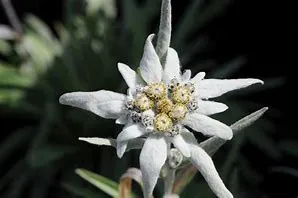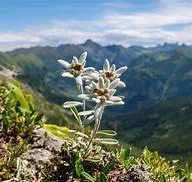Edelweiss (Leontopodium alpinum) is a captivating mountain flower with a rich cultural history. Let’s delve into its habitat, appearance, and fascinating details:
- Habitat and Geographic Distribution:
- Edelweiss is native to the Himalayas and Siberia, but it settled in the mountains of Europe and the Holarctic regions during glacial periods.
- Its distribution extends along the highest areas of Europe and Asia.
- You’ll find this resilient flower in rocky limestone places at altitudes ranging from 1,800 to 3,400 meters (approximately 5,900 to 11,200 feet) above sea level.
- It thrives under extreme conditions: high ultraviolet radiation, low atmospheric pressure, and temperature fluctuations.
- Edelweiss has become the national flower of Switzerland and is widely distributed across European mountains, from the Jura and Pyrenees to the Carpathians.
- Appearance:
- Each edelweiss bloom is a work of art:
- The flower heads consist of up to six small yellow clustered spikelet-florets surrounded by fuzzy white “petals” (technically, bracts).
- The leaves and flowers are covered with dense white hairs, which protect the plant from cold, aridity, and ultraviolet radiation.
- Flowering stalks can grow to 3–20 centimeters (1–8 inches) in the wild or even up to 40 centimeters (16 inches) under cultivation.
- Its life expectancy varies between 3 and 10 years.
- Each edelweiss bloom is a work of art:
- Symbolism and Cultural Significance:
- Edelweiss is a symbol of rugged beauty, purity, and alpinism.
- It’s a national symbol in several countries, including Austria, Slovenia, Switzerland, and Italy.
- In Romania, it was declared a “monument of nature.”
- Folk tradition suggests that giving an edelweiss flower to a loved one signifies a promise of dedication.
- Endangered Status:
- Due to its historical popularity, edelweiss was widely collected for decorative and medicinal purposes, leading to its endangerment.
- It is now a protected species and cannot be collected.
- The Edelweiss day is celebrated on March 5th.
In summary, the edelweiss is a resilient alpine gem, cherished for its beauty and cultural significance.
Let’s explore the fascinating world of the edelweiss flower. 🌼
Edelweiss (Leontopodium nivale) is a captivating mountain flower that belongs to the daisy or sunflower family (Asteraceae). Here are some intriguing details about this alpine gem:
- Appearance and Habitat:
- Edelweiss thrives in rocky limestone areas at altitudes ranging from 1,800 to 3,400 meters (approximately 5,900 to 11,200 feet) above sea level.
- Its leaves and flowers are covered with dense white hairs, giving them a woolly appearance.
- The flowering stalks can grow up to 20 centimeters (about 8 inches) in the wild or even up to 40 centimeters (around 16 inches) under cultivation.
- Each bloom consists of small yellow clustered spikelet-florets surrounded by fuzzy white “petals” (technically, bracts) arranged in a double-star formation.
- Symbolism and Cultural Significance:
- Edelweiss has become a symbol associated with national pride in several countries, including Austria, Switzerland, Slovenia, and Italy.
- It represents rugged beauty, purity, and the spirit of alpinism.
- In Romania, it was even declared a “monument of nature” in 1931.
- Folk tradition suggests that giving an edelweiss flower to a loved one signifies a promise of dedication.
- Growing Edelweiss:
- These hardy flowers are naturally found in harsh, arid conditions and do not require much water once established.
- Edelweiss can be grown in USDA hardiness zones 4 to 7.
- They make wonderful additions to rock gardens, adding a rugged and wild feel to your backyard.
- Names and Etymology:
- The common name “Edelweiß” is German, combining “edel” (noble) and “weiß” (white).
- In Slovenian, it is known as “planika”, meaning mountain girl.
- In the Italian-speaking Alps, it’s called “Stella Alpina”, and in the French Alps, it’s referred to as “étoile des Alpes” (star of the Alps).
- The scientific name Leontopodium is a Latinization of the Greek term for “lion’s paw”.
- The Latin specific epithet “nivale” means “snow” or “snowy”.
So next time you encounter an edelweiss, remember its resilience, beauty, and the rich cultural significance it carries. 🏔️🌸

How do I take care of my edelweiss plant?
Edelweiss (Leontopodium alpinum) is a remarkable alpine flower known for its woolly foliage and star-shaped white blooms. While it’s commonly associated with the European Alps, it’s actually native to the Himalayas and Siberia. Here are some care tips to help your edelweiss thrive:
- Sunlight:
- Full sun or dappled shade is ideal for edelweiss. Mimic its natural habitat by providing ample sunlight.
- Consider planting it underneath taller plants to offer some protection from the elements while still allowing dappled sunshine.
- Soil:
- Edelweiss prefers well-draining soil.
- Rocky, limestone soil is perfect for these hardy plants.
- Aim for a nearly neutral pH level (between 6.5 and 7.5).
- A mix of compost, sand, grit, and peat moss works well for growing edelweiss.
- Watering:
- During the first year, water your edelweiss until it establishes itself.
- Once established, reduce watering significantly.
- These tough plants are naturally found in harsh, arid conditions and do better with underwatering than overwatering.
- Temperature and Humidity:
- Edelweiss thrives in cold temperatures.
- It’s grown in USDA hardiness zones 4 to 7.
- Wooly leaves protect the plant from wind and rain.
- Avoid Hot, Humid Climates:
- Edelweiss doesn’t fare well in hot, humid environments.
- If you’re in a region with such conditions, consider growing it in a controlled environment like a rock garden.
Remember, edelweiss is a slow grower, and it typically starts flowering in its second year. Enjoy the rugged beauty of this alpine gem!
What are some common pests and diseases that affect edelweiss?
Edelweiss (Leontopodium alpinum) is a hardy alpine flower known for its woolly foliage and star-shaped white blooms. While it’s often associated with the European Alps, it’s actually native to the Himalayas and Siberia. Here are some care tips for your edelweiss, followed by information on common pests and diseases:
- Edelweiss Care:
- Sunlight: Plant it in full sun or dappled shade. Mimic its natural habitat by providing ample sunlight.
- Soil: Well-draining soil is essential. Rocky, limestone soil works best.
- Watering: During the first year, water your edelweiss until it establishes itself. Once established, reduce watering significantly.
- Temperature and Humidity: Edelweiss thrives in cold temperatures. It’s grown in USDA hardiness zones 4 to 7.
- Avoid Hot, Humid Climates: Edelweiss doesn’t fare well in hot, humid environments.
- Common Pests and Diseases:
- Pests:
- Aphids: These tiny insects can attack edelweiss, causing damage to leaves and flower buds. Use insecticidal soap to get rid of them.
- Spider Mites: These pests can also harm the leaves and buds. Regular inspection and treatment are essential.
- Caterpillars: Keep an eye out for caterpillars and address them promptly.
- Diseases:
- Powdery Mildew: A fungal disease that can affect the leaves. Proper air circulation and avoiding overhead watering help prevent it.
- Rust: Another fungal issue that can cause yellow spots on leaves.
- Botrytis: This gray mold can affect both leaves and flowers. Ensure good ventilation and avoid excess moisture.
- Pests:
Remember, edelweiss is a slow grower, typically flowering in its second year. Enjoy its rugged beauty and resilience!
What are some interesting facts about edelweiss?
Let’s explore some intriguing facts about the edelweiss flower:
- Symbol of Alpine Beauty:
- Edelweiss (Leontopodium nivale) is a mountain flower belonging to the daisy or sunflower family (Asteraceae).
- It thrives in rocky limestone places at altitudes ranging from 1,800 to 3,400 meters (approximately 5,900 to 11,200 feet) above sea level.
- The plant’s leaves and flowers are covered with dense white hairs, which protect it from cold, aridity, and ultraviolet radiation.
- Cultural Significance:
- Edelweiss is a national symbol in several countries, including Austria, Slovenia, Switzerland, and Italy.
- In Romania, it was declared a “monument of nature” in 1931.
- Folk tradition suggests that giving an edelweiss flower to a loved one is a promise of dedication.
- Name Origins:
- The flower’s common name “Edelweiß” is German, combining “edel” (noble) and “weiß” (white).
- In Slovenian, it is known as “planika”, meaning mountain girl.
- In the Italian-speaking Alps, it’s called “Stella Alpina”, and in the French Alps, it’s referred to as “étoile des Alpes” (star of the Alps).
- Historical Usage:
- Edelweiss achieved wide usage during the early days of Alpine tourism.
- Alternative names include “Chatzen-Talpen” (cat’s paws) and the older term “Wullbluomen” (wool flower).
- Scientific Etymology:
- The scientific name Leontopodium is a Latinization of the Greek term for “lion’s paw”.
- The Latin specific epithet “nivale” means “snow” or “snowy”.
- Endangered Status:
- Due to historical popularity, edelweiss was widely collected, leading to its endangerment.
- It is now a protected species and cannot be collected.
Remember, this alpine gem embodies rugged beauty and cultural significance!
FAQs: Edelweiss Flower
A1: The Edelweiss flower is a small, white, star-shaped flower known for its beauty and rarity. It is native to the mountainous regions of Europe and Asia and is often associated with Alpine culture.
A2: The Edelweiss flower grows in high altitude areas of the Alps, the Carpathians, and other mountain ranges in Europe and Asia. It thrives in limestone soils and requires specific climatic conditions to grow.
A3: Yes, the Edelweiss flower is considered endangered in some regions due to overharvesting and habitat destruction. Conservation efforts are in place in various countries to protect and preserve this iconic species.
A4: Yes, with the right conditions, the Edelweiss flower can be cultivated in gardens. It requires well-drained, lime-rich soil, full sun, and cool temperatures to thrive, mimicking its natural Alpine habitat.
A5: The Edelweiss flower symbolizes courage, love, and dedication. It is often given as a gift to symbolize deep respect and admiration, reflecting its challenging growth conditions and the effort required to obtain it.

I don’t think the title of your article matches the content lol. Just kidding, mainly because I had some doubts after reading the article.
Thank you for your sharing. I am worried that I lack creative ideas. It is your article that makes me full of hope. Thank you. But, I have a question, can you help me?